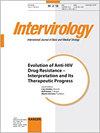The Influence of Antiretroviral Therapy on Hepatitis C Virus Viral Load and Liver Fibrosis in Human Immunodeficiency Virus-Coinfected Patients: An Observational Study
IF 1.8
4区 医学
Q3 VIROLOGY
引用次数: 1
Abstract
Background: The role of antiretroviral therapy (ART) for Hepatitis C viral load (HCV-VL) and liver fibrosis is poorly understood. This study aimed at evaluating the influence of ART on HCV-VL and liver fibrosis in human immunodeficiency virus (HIV)/HCV-coinfected patients. Methods: We conducted a retrospective cohort study of HIV/HCV-coinfected patients followed at a tertiary university hospital. Results: In total, 143 patients were included. In 61 patients, ART initiation was accompanied by an increase in HCV-VL and a decrease in HIV viral load (HIV-VL), whereas ART suspension led to a decrease in HCV-VL and an increase in HIV-VL. Among the 55 HIV-suppressed patients who switched to a raltegravir (RAL)-containing regimen, median HCV-VL levels decreased significantly, while switching to a rilpivirine-containing regimen did not yield a significant reduction. Discussion: If the treatment of chronic hepatitis starts before ART, ART initiation should be delayed as much as possible. If ART has been started, it is advisable to wait 1 year before initiating chronic hepatitis treatment. RAL as the third agent in an ART regimen could be beneficial in HIV/HCV-coinfected patients, in comparison to other antiretroviral drugs. Conclusion: The start and the suspension of ART significantly interferes with HCV-VL in HIV/HCV-coinfected patients.抗逆转录病毒治疗对免疫缺陷病毒感染者丙型肝炎病毒载量和肝纤维化影响的观察研究
背景:抗逆转录病毒疗法(ART)对丙型肝炎病毒载量(HCV-VL)和肝纤维化的作用尚不清楚。本研究旨在评估ART对人类免疫缺陷病毒(HIV)/HCV联合感染患者的HCV-VL和肝纤维化的影响。方法:我们对一所三级大学医院的HIV/HCV合并感染患者进行了回顾性队列研究。结果:共纳入143例患者。在61名患者中,ART启动伴随着HCV-VL的增加和HIV病毒载量(HIV-VL)的降低,而ART悬浮液导致HCV-VL的降低和HIV-VL的增加。在55名HIV抑制的患者中,转投含雷替拉韦(RAL)的方案后,中位HCV-VL水平显著降低,而转投含利匹韦林的方案后没有显著降低。讨论:如果慢性肝炎的治疗在ART之前开始,则应尽可能推迟ART的开始。如果ART已经开始,建议等待1年后再开始慢性肝炎治疗。与其他抗逆转录病毒药物相比,RAL作为ART方案中的第三种药物可能对HIV/HCV共感染患者有益。结论:ART的开始和暂停对HIV/HCV合并感染患者的HCV-VL有显著干扰作用。
本文章由计算机程序翻译,如有差异,请以英文原文为准。
求助全文
约1分钟内获得全文
求助全文
来源期刊

Intervirology
医学-病毒学
CiteScore
5.40
自引率
0.00%
发文量
13
审稿时长
6-12 weeks
期刊介绍:
''Intervirology'' covers progress in both basic and clinical virus research, and aims to provide a forum for the various disciplines within virology. Issues publishing original papers alternate with thematic issues, focusing on clearly defined topics. This thematic concentration serves to make timely reviews, research reports and controversy easily accessible to both specialists in the field and those who want to keep track of the latest developments outside their own area of interest. In addition to original papers, regular issues publish short communications and letters to the editor to provide readers with a forum for the exchange of ideas and comments. The scope encompasses work on the molecular biology of human and animal viruses, including genome organization and regulation, and the structure and function of viral proteins. The pathogenesis, immunology, diagnosis, epidemiology, prophylaxis and therapy of viral diseases are considered.
 求助内容:
求助内容: 应助结果提醒方式:
应助结果提醒方式:


